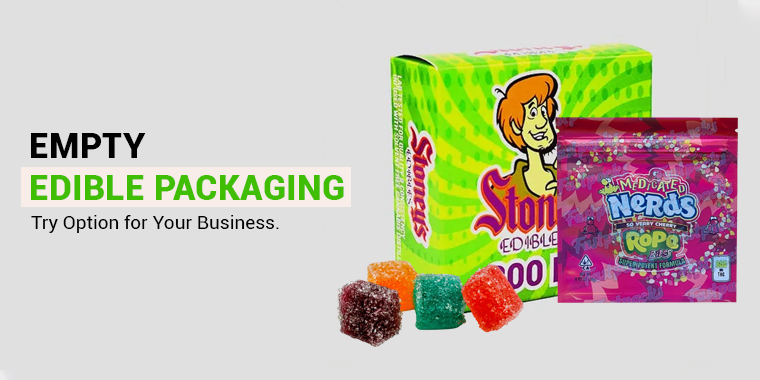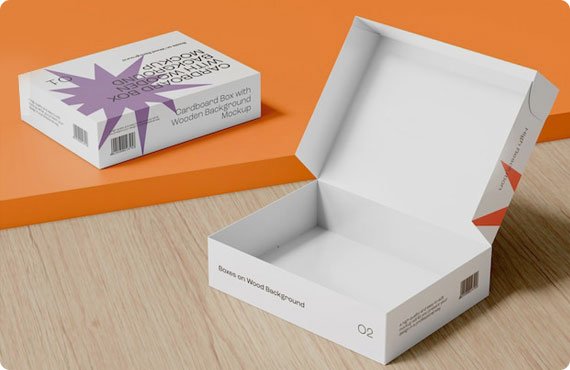September 24, 2025

Want to appeal to eco-conscious buyers and make your food brand pop up in the market? Empty edible packaging is a smart choice to reduce pollution and deliver food with intact quality. In contrast to usual packaging with metallic coatings, edible boxes do not react with food, preserving food quality from heat and UV rays.
Whether you are running an established retail brand or are new in the market and want to stun buyers with eco-chic packaging? You are in the right place. Empty edible boxes are a genius choice that leaves zero waste. Due to 100% sustainability, it is perfect to upscale your brand image.
Let's find out where it is used, how it is better than other food packaging, possible drawbacks, and future trends.
There are versatile options of edible packaging to fulfill the requirements of every client. Some like edible plates, while others love to spoon with special flavor and taste. Let’s check some of the options that are popular in today’s market.
Edible spoons are an alternative to metal or plastic spoons. They are used in some special treats to make any event unforgettable. They are ideal to reduce packaging waste while providing new tastes.
They are used for eating yogurt, rice, and ice cream. For drinking hot soup, edible spoons are the best choice. They are mostly used in weddings and private parties to leave no waste behind.
Edible straws are safer and more eco-friendly than plastic straws. Because they do not produce packaging waste, they are the first choice of eco-conscious brands. They are used to sipping juices, coffee, cocktails, or soft drinks with a fresh taste.
Edible cups are made of edible items. They do not produce waste anymore. Many eco-friendly brands are adopting these cups to minimize packaging waste while providing a unique drinking experience.
They are used to sip soup, coffee, cocktails, and other beverages. They are also used to eating ice cream with an intact taste and fresh quality. People are using them during events, wedding parties, and air travel.
Edible plates are more eco-friendly than plastic plates. They are used to delivering treats safely without leaving waste. These plates produce zero waste and are eaten later on.
They are used in special parties, weddings, green events, and airline travel for eating rice, mutton, and other delicious treats.
Edible cones are the best option to eat ice cream with the ultimate experience. They are best at protecting ice cream by delivering every bite with a delicious taste. These cones offer, with these cones, you can enjoy a blend of crispy wafer and creamy ice cream at the same time. They are popularly used to eat ice cream for a mesmerizing eating experience.

Edible packaging has proven to be a game-changer in driving business success. Below are the five brand-driven benefits of empty edible packaging.
One of the best things about empty edible packaging is that it does not leave packaging waste behind. After unwrapping the product, you can eat it, which significantly reduces packaging waste. It does not pollute the environment. This approach appeals to eco-conscious buyers towards your brand, leaving a lasting impression. So, use such packaging to stun eco-lover customers, earn good fame, and get new customers rushing towards your offerings. For preserving product quality, use edible mylar bags and satisfy customers on every delivery.
There is a shift in customer interests and behavior over time. Now, the market has been shifting towards sustainable packaging to meet customers' desires. People are attracted to the sustainability of packaging. Therefore, to make your brand customers’ number one choice, use eco-friendly packaging.
One of the eco-friendly options is empty edible packaging. It biodegrades easily. Due to their fragrant aroma and delicious taste, people mostly eat them. It means this packaging produces zero waste. Hence, use this box to build customers' trust and multiply brand fame.
A core responsibility of packaging is to preserve product quality. Only durable and contamination-free packaging can preserve products' quality. Therefore, every retail brand likes to use edible packaging to protect product quality.
This packaging is made from edible components, including starch, galactic milk protein, and algae. These components are edible. These safe and contaminant-free components do not react with products, preserving the product with its original quality and composition. Durable food boxes also protect your edible items from spoilage and deliver them in fresh and flavorful quality.
Empty edible packaging is an eco-chic option that does not create packaging waste after usage. Made with easily biodegradable materials, this packaging does not create environmental waste. Many retail brands are preferring this type of packaging to contribute to a green environment that engages buyers. If you want to preserve product quality and environmental integrity, use edible mylar bags. These bags are the top-rated choice of eco-conscious buyers. Hence, use them to create a positive image of your brand and leave a lasting impression in this digital marketplace.
As empty edible packaging is used to protect packed products. Therefore, it does not require additional wrapping for protecting products. Rice on edible plates is easy to carry. You can eat them with an edible spoon. After enjoying the spicy taste and fragrant flavor, you can eat the plate and the spoon. And no waste left behind. That is a unique and stunning idea to wow customers and memorize your brand name.
In addition to the limitless benefits of edible packaging, it has a few drawbacks, such as
In contrast to usual packaging, empty edible packaging is not very long-lasting. So it provides a less-barrier shield to edible items. Therefore, these boxes do not withstand harsh conditions, minimizing the shelf life of products.
Some of the components in empty edible packaging can cause allergic reactions with products inside. This reaction can spoil products, losing their quality, taste, and texture. Hence, verify before placing the products; they don't react with each other.
Empty edible packaging is made with starch, gelatin, protein, and organic materials, which are relatively costly. Moreover, there is a complex process to make packaging that has a shorter shelf life. This fragile packaging costs more than traditional packaging. It will harm your business.
The future of edible packaging is brightened due to decreasing packaging waste and offering unique eating experiences. With advancements in technology and innovation in biomass, including scratch, algae, and rice paper, there are means to enhance the production of edible boxes. Their steady growth can reduce packaging costs, offering affordable packaging for new or running businesses.
According to a study by Cone Communications CSR USA, “out of 1000 customers, 92% trust the eco-conscious brands.” Therefore, use empty edible boxes to build customers' trust in your brand and create a splash in the food industry.
Empty edible packaging is best to reduce packaging waste and present your delicious treats with a luxurious style. Made with plastic-free components, they ensure the products are preserved with their original quality. These boxes are best to enhance your brand image in the eyes of eco-conscious buyers and elevate your brand awareness. In spite of their numerous benefits, they can still harm the quality of some food products.
Are you looking for custom empty edible boxes? Contact Custom Designs Boxes to meet your packaging needs with a fast customization turnaround time. We use our decade of experience to make boxes without any errors. Shipping is free and quick. Email us at sales@customdesignsboxes.com today. You get free design assistance with endless packaging options. Request a free quote today!
Find the perfect packaging solutions tailored to your industry niche.
Don't just imagine – experience excellence up close, as you can check our superior craftsmanship before making your decision by ordering your sample kit.
